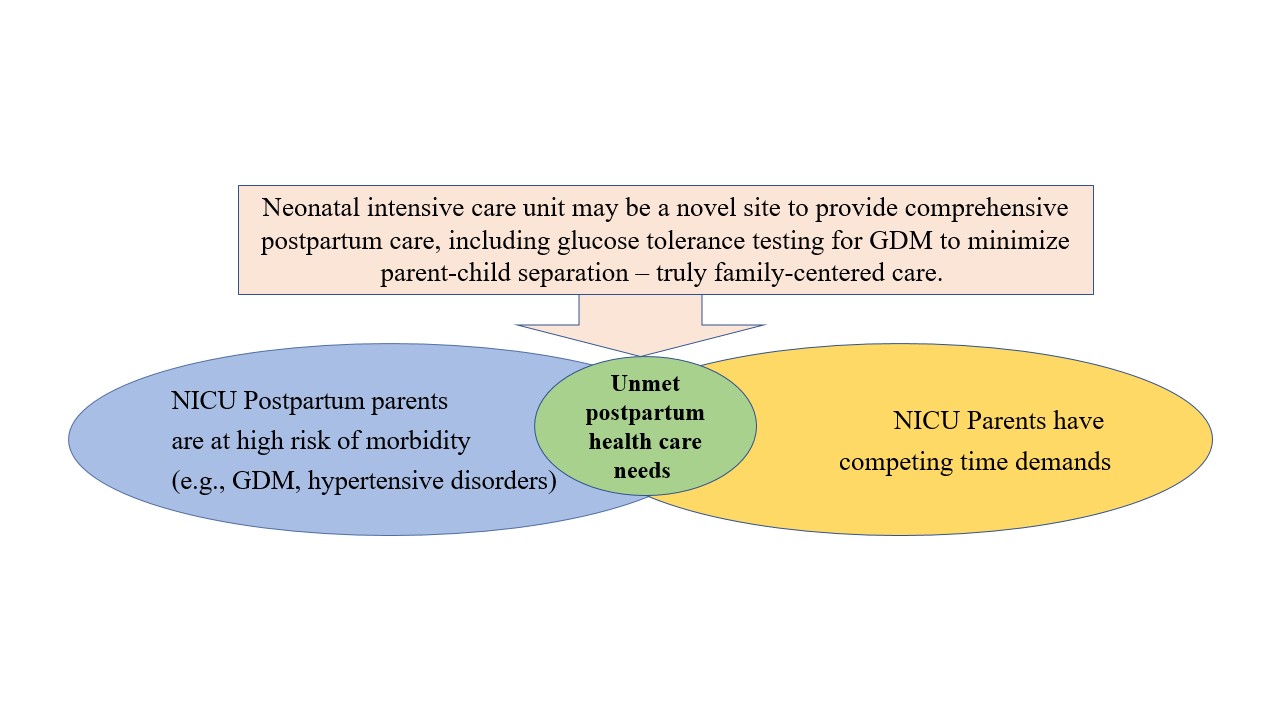Neonatology
Session: Neo-Perinatal Health Care Delivery 4: Epidemiology/Health Services Research
274 - NICU Parents with Gestational Diabetes are Missing Postpartum Type 2 Diabetes Screening
Sunday, May 5, 2024
3:30 PM - 6:00 PM ET
Poster Number: 274
Publication Number: 274.1817
Publication Number: 274.1817

Taneisha Sinclair, MD (she/her/hers)
Resident Physician
Childrens Hospital of Philadelphia
Philadelphia, Pennsylvania, United States
Presenting Author(s)
Background: Postpartum parents of infants in the neonatal intensive care unit (NICU) are more likely to have chronic diseases and unmet healthcare needs than parents of well newborns (Figure 1). Gestational diabetes mellitus (GDM) increases the risk of developing type 2 diabetes mellitus (T2DM) later in life. Postpartum oral glucose tolerance tests (OGTT) at 4–12 weeks are recommended for T2DM screening by the American College of Obstetricians and Gynecologists and the American Diabetes Association for all individuals with GDM. OGTT as early as 2 days postpartum has similar diagnostic value. < 50% of postpartum individuals with GDM are screened for T2DM; only 35 % at our institution in 2019. The screening rate for NICU parents is unknown, but potentially modifiable given frequent touch points with healthcare.
Objective: Identify NICU parents with GDM and determine predictors of OGTT completion within 12 weeks postpartum.
Design/Methods: We queried electronic medical records of all inborn NICU infants with length of stay (LOS) of >4 days from Jan 1, 2018–Dec 31, 2020, whose parents had GDM identified using problem lists and billing codes. Birth certificate data were used for variables unavailable in the EMR. Each chart was manually reviewed to confirm GDM diagnosis and to ascertain postpartum OGTT completion. We performed bivariable and multivariable analyses to identify characteristics associated with OGTT testing.
Results: We identified 76 NICU parents with GDM with infant LOS >4 days; median (IQR) LOS was 24 (10-40) days. Only 13 (17%) of NICU parents with GDM completed an OGTT within 12 weeks postpartum. In bivariate analyses, individuals with preexisting hypertension were less likely than those without hypertension to have OGTT (0% vs. 30%, p = 0.03). There were no statistically significant differences in any other characteristics between those with postpartum OGTT and those without (Table 1). Among those with OGTT completion, 92.3% also had a postpartum visit compared to just 2% OGTT completion among those without a postpartum visit (P=0.09). However, even among individuals with a postpartum visit (n=54), only 12 (22%) completed an OGTT. In multivariable regression models, there was no difference in lack of OGTT (Table 2).
Conclusion(s): The proportion of NICU birthing parents with GDM who completed postpartum OGTT screening was extremely low. This may be modifiable given parental NICU presence for weeks to months after birth. Co-location of postpartum health screening and services should be prioritized to improve the health of this high-risk group.

Table 1 PAS 2024.jpeg
Table 2 PAS 2024.jpeg
